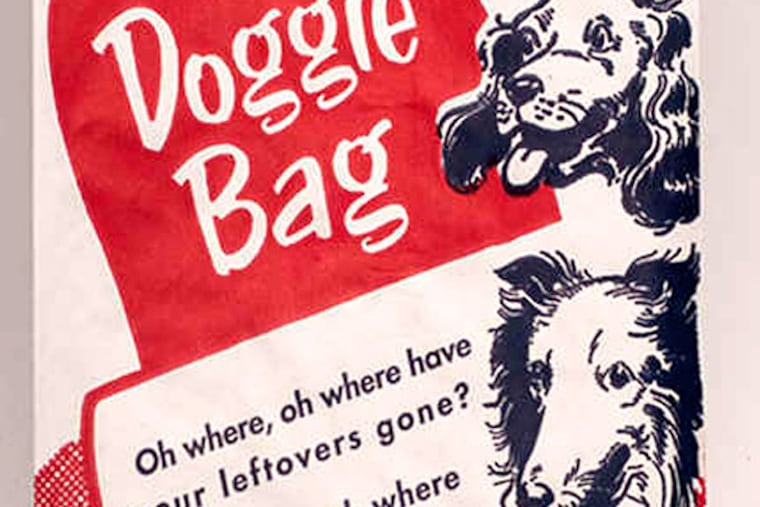Uncertain origins of American doggy bag
Taking home leftovers from a restaurant these days is as American as the apple pie you did not finish for dessert.

Taking home leftovers from a restaurant these days is as American as the apple pie you did not finish for dessert.
It was not always so.
Anyone who grew up in the '60s and '70s is likely to recall that what you left on your plate at an eatery was carried back to the kitchen, never to be seen again. That is, unless, it was steak or some other hunk of meat.
For that, you'd ask for a doggy bag.
Recalling my own experiences working at the Pub, the Cherry Hill Inn, and Cherry Hill Lodge while in high school, the routine called for the server to take your plate back to the kitchen and return with a grease-resistant paper sack neatly folded at the top, and what remained of your steak or chicken inside.
The presumption, of course, was that it was for the dog. But we knew better.
And so did Emily Post, etiquette maven of the era, who disapproved of taking home restaurant leftovers for personal consumption, calling it "degrading."
But in 1975, she reversed herself, telling the New York Times: "Now, with the cost of food and the enormous proportions in the restaurant, and the starvation in the world, you just hate to see waste."
And over the years, thanks to an explosion in take-out and chain restaurants, a multibillion-dollar industry has sprung up to produce the paper, aluminum, plastic, and Styrofoam containers for that food you are taking home. The meat or fish still on your plate. The vegetables. The salad, if you so desire. And that piece of cake you could not finish. Each course packaged separately.
The origins of the humble doggy bag are matters of debate and speculation.
Some writers point to the ancient Roman tradition of taking home leftovers in a napkin as the true beginning of the practice.
But the doggy bag as we knew it appears to have come into being during World War II or the years after, when steak restaurants proliferated, and waste was frowned upon.
One name that pops up in researching the history of the doggy bag is Dan Stampler, owner in the late 1940s of the Steak Joint in New York's Greenwich Village.
In their book The Lexicon of Real American Food, Jane and Michael Stern write that Stampler came up with the idea so budget-conscious customers would not be embarrassed to ask for a container to take home the bones and any remaining meat, supposedly as a pet treat.
According to the Sterns, Stampler then had the bag produced by the Bagcraft Corp. in Chicago with a picture of his Scottish terrier on it.
But in a 1985 interview with the Chicago Tribune, Bagcraft's then-owner Janice Meister said her late husband, Albert, and his partner, Norman Ressner, came up with the idea when they founded the company in 1948.
"Al and Norm had noticed how much food is left over in restaurants, so they decided the thing to do was to make a plus out of it," she told the newspaper. "Ostensibly, it was for the dog, but most people know it's not going to end up that way."
Tens of millions of bags later, Bagcraft is still producing the 43/4-by-3-by-12- inch two-ply sack featuring five happy-looking dogs framing a poem composed by Janice Meister herself:
Oh where, oh where have your leftovers gone?
Oh where, oh where can they be?
If you've had all you can possibly eat,
Please bring the rest home to me.
Stampler's short obituary in 1986 in the New York Times made no mention of any possible role in the doggy bag, but then again, it also did not note that he had designed a two-pronged wine-bottle-cork extractor, which he sold as the "Steak Joint Korker," U.S. Patent No. 3,257,873, issued in 1966.
Barak Bright, marketing director for the firm now known as BagcraftPapercon, said the doggy bag - or rather, updated versions of it - is poised for a comeback because paper is more environmentally sound than foam or plastic.
"What we are seeing today is a rebirth of the paper doggie bag," he said in an e-mail, "but in new sizes and constructions."
In yet another origin story, Jesse Rhodes, writing for Smithsonian.com, says containers for leftovers for pets came about during World War II, when owners were encouraged to feed their animals table scraps.
In 1943, he says, cafés in San Francisco offered patrons Pet Pakits, cartons they could use to take food home to their dogs or cats. Hotels in Seattle, about the same time, started offering waxed-paper bags with a label saying, "Bones for Bowser."
A Google search for "Pet Pakits" turns up records on an abandoned 1996 trademark, and a search for "Bones for Bowser" returns a recipe for a vegetarian dog treat, so it appears the names did not have staying power.
To confuse matters, Merriam-Webster.com says the first known use of a doggy bag dates to 1963.
So whatever the origin of the term, one thing is clear: We've probably been taking home leftovers in one container or another since there was anything left to take home.